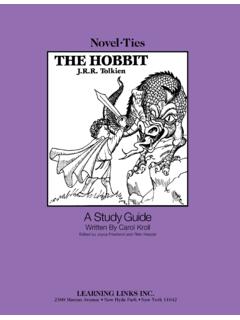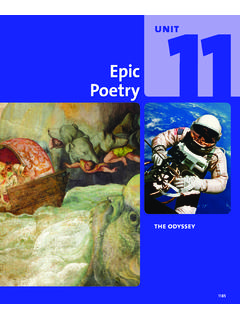Transcription of Language Arts Literature Textbook 8th Grade Mr. Sparks
1 1 Language Arts Literature Textbook 8th grade Mr. Sparks 2 Table of Contents Short Stories 1. 2 BRO2B by Kurt Vonnegut ..7 2. Charles by Shirley Jackson ..13 3. The Lottery by Shirley Jackson ..17 4. The Cask of Amontillado by Edgar Allan Poe ..24 5. Young Goodman Brown by Nathaniel Hawthorne ..30 6. A Rose for Emily by William Faulkner ..38 7. Harrison Bergeron by Kurt 8. The Bet by Anton 9. The Fall of the House of Usher by Edgar Allan Poe ..55 10. The Sound of Thunder by Ray 11. The Minister s Black Veil by Nathaniel 12. The Possibility of Evil by Shirley Jackson ..83 13. There Will Come Soft Rains by Ray 14. The Tell-Tale Heart by Edgar Allan 15. The Monkey s Paw by WW 16. The Veldt by Ray Bradbury ..107 Poetry 1. Nothing Gold Can Stay by Robert 2. The Raven by Edgar Allan Poe ..125 3. I know why the caged bird sings by Maya 4. Annabel Lee by Edgar Allan Poe ..124 5. Do Not Go Gentle Into That Good Night by Dylan 6.
2 All the World s a Stage by William Shakespeare ..123 7. O Captain! My Captain! by Walt Whitman ..122 8. And Death Shall Have No Dominion by Dylan Thomas ..120 9. Self-Pity DH Lawrence ..120 10. If you forget by Pablo Neruda ..122 11. In Praise of Feeling Bad About Yourself by Wislawa Dramas 1. A Midsummer Night s Dream by William 2. Twelve Angry Men by Reginald Rose ..187 Informative Texts 1. Civil Disobedience by Henry David 2. Letter from a Birmingham Jail by MLK Jr..231 3. Self-Reliance by Ralph Waldo 3 Short Stories A short story is fictional composition that ranges in length from 1,000 to 20,000 words. Edgar Allan Poe, in his essay The Philosophy of Composition, said that a short story should be read in one sitting, anywhere from a half hour to two hours. Because of the shorter length, a short story usually focuses on one plot, one main character with few minor characters. While a novel can possess numerous themes, characters, plot lines, and other such devices, short stories generally rely on singular devices.
3 Short stories also experiment with different styles and approaches, which has made them quite popular. Learning Objectives of Short Stories Students will be able to: Identify elements of plot including setting Analyze the development of plot in a narrative text Analyze a character s personality and determine motivation Identify and differentiate between internal and external conflict Make inferences based on information provided Identify figurative Language in fiction Convey proper tone in a writing piece Recognize theme within a text, citing textual support Identify examples of foreshadowing and determine author s purpose for using them Determine author s purpose for a specific composition. Short Story Literary Terms and Author Devices Literary terms and devices are elements that appear in most fiction prose, used for both style and storytelling. As both readers and authors it is important to understand and be able to identify them.
4 Being able to do so will not only allow a better understanding of a story, but allow you the skills that you can evaluate and critique writing. The terms that are in BOLD are terms and devices that author s use to give their writing style and meaning. The terms that are ITALICIZED are thinking skills that authors and readers use to gain understanding and meaning of a text. Alliteration The repetition at close intervals of initial identical consonant sounds. Or, vowel sounds in successive words or syllables that repeat. Allusion An indirect reference to something (usually a literary text) with which the reader is expected to be familiar. Allusions are usually literary, historical, Biblical, or mythological. Analogy An analogy is a comparison to a directly parallel case. When a writer uses an analogy, he or she argues that a claim reasonable for one case is reasonable for the analogous case. Analyze To focuses on how plot/structure, character, setting, and many other techniques are used by the author to create meaning.
5 4 Antagonist- the character in a narrative or play who is in conflict with the main character; an antagonist may not even be a person, or may be the same person as the main character. Archetype A term borrowed by psychologist Carl Jung who described archetypes as "primordial images" formed by repeated experiences in the lives of our ancestors, inherited in the "collective unconscious" of the human race and expressed in myths, religion, dreams, fantasies, and Literature . These "images" of character, plot pattern, symbols recur in Literature and evoke profound emotional responses in the reader because they resonate with an image already existing in our unconscious mind, death, rebirth. Characterization The method an author uses to develop characters in a work. In direct characterization, the author straightforwardly states the character s traits. With indirect characterization, those traits are implied through what the character says, does, how the character dresses, interacts with other characters, etc.
6 Conflict-- The struggle between the protagonist(s) and antagonist(s). There are six kinds of conflict to be covered this year: Character v. Character: Two characters that oppose one another Character v. Group: A subgroup of society persecutes an individual Character v. Nature: The natural world opposes a character Character v. Self: A character suffers from a mental opposition ( illness, guilt, etc.) Character v. Society: When a society is oppressive and terroristic Character v. Supernatural: When the opposition is of a fantastical origin Connotation Rather than the dictionary definition, the associations associated by a word. Implied meaning rather than literal meaning or denotation. Deduction A form of reasoning that begins with a generalization, then applies the generalization to a specific case or cases. Epigraph A quotation or aphorism at the beginning of a literary work suggestive of a theme. One found at the beginning of John Kennedy Toole's Confederacy of Dunces: "When a true genius appears in the world, you may know him by this sign; that all the dunces are in a confederacy against him.
7 " Jonathan Swift. Epiphany A major character's moment of realization or awareness. Exposition Background information provided by a writer to enhance a reader's understanding of the context of a fictional or nonfictional story. Figurative Language A word or words that are inaccurate literally, but describe by calling to mind sensations or responses that the thing described evokes. Figurative Language may be in the form of metaphors or similes, both non-literal comparisons. Shakespeare's "All the world's a stage" is an example of non-literal figurative Language (metaphor specifically). Flat Character A character constructed around a single idea or quality; a flat character is immediately recognizable. Foil A character whose traits are the opposite of another and who thus points up the strengths and weaknesses of the other character. Foreshadowing-- The use of hints or clues to suggest what will happen later in the story. Genre French, a literary form or type; classification.
8 Tragedy, comedy, novel, essay, poetry. 5 Hyperbole Conscious exaggeration used to heighten effect. Not intended literally, hyperbole is often humorous. Example: "And fired the shot heard round the world." Imagery The use of images, especially in a pattern of related images, often figurative; to create a strong unified sensory impression. Irony When a reader is aware of a reality that differs from a character's perception of reality (dramatic irony)/ The literal meaning of a writer's words may be verbal irony. Generally speaking, a discrepancy between expectation and reality. Literary Criticism-- is the study, evaluation, and interpretation of Literature . Metaphor A comparison of two things, often unrelated. Metaphors may occur: in a single sentence "Talent is a cistern; genius is a fountain;" or can appear as a central idea of an entire work. Mood An atmosphere created by a writer's word choice (diction) and the details selected. Syntax is also a determiner of mood because sentence strength, length, and complexity affect pacing.
9 Motif A frequently recurrent character, incident, or concept in Literature . Motivation-- Values, desires, and/or beliefs that cause a character to act the way that they do; Reasons why a character thinks, behaves, and feels a certain way. Onomatopoeia The use of a word whose pronunciation suggests its meaning. "Buzz," "hiss," "slam," and "pop" are commonly used examples. Oxymoron A writer s tool that juxtaposes two contradictory terms, like "wise fool" or "deafening silence." Paradox A seemingly contradictory statement or situation which is actually true. This device is often used for emphasis or simply to attract attention. Personification Figurative Language in which inanimate objects, animals, ideas, or abstractions is endowed with human traits or human form "When Duty Plot System of actions represented in a dramatic or narrative work. Point of View (POV) The perspective from which a fictional or nonfictional story is told. a. First Person POV In the first person point of view, the narrator does participate in the action of the story.
10 When reading stories in the first person, we need to realize that what the narrator is recounting might not be the objective truth. We should question the trustworthiness of the accounting. b. Third Person POV Here the narrator does not participate in the action of the story as one of the characters, but lets us know exactly how the characters feel. We learn about the characters through this outside voice. c. Omniscient A narrator who knows everything about all the characters is all knowing, or omniscient. d. Limited Omniscient A narrator whose knowledge is limited to one character, either major or minor, has a limited omniscient point of view. Predicting- Using contextual clues to hypothesize a chain of events in a piece of Literature . 6 Protagonist Chief character in a dramatic or narrative works, usually trying to accomplish some objective or working toward some goal. Pun A play on words that are identical or similar in sound but have sharply diverse meanings.








